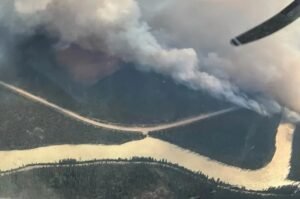
Jasper National Park, one of Canada’s most treasured natural wonders, is grappling with the aftermath of a significant wildfire. This recent blaze has not only charred vast expanses of wilderness but has also brought to the forefront the pressing need for enhanced environmental vigilance. In this article, we will explore the impact of the wildfire, the response efforts, and the steps necessary to prevent future incidents.
The Impact of the Wildfire
The wildfire in Jasper National Park has left a profound impact on the region’s ecosystem, wildlife, and local communities. The blaze, fueled by dry conditions and strong winds, spread rapidly, consuming large areas of forest and grassland.
Ecological Devastation
The ecological impact of the wildfire is immense. Thousands of hectares of pristine wilderness have been reduced to ash, affecting the park’s biodiversity. The loss of vegetation not only disrupts the habitat of countless species but also increases the risk of soil erosion and water runoff, which can lead to long-term environmental degradation.
Threat to Wildlife
Many animals have been displaced from their natural habitats, and some have perished in the blaze. Species that rely on the park’s unique ecosystem for survival, such as elk, moose, and various bird species, face an uncertain future as their food sources and shelters have been destroyed.
Impact on Local Communities
The park is a significant source of tourism and economic activity, and the destruction of natural landscapes threatens livelihoods and the local economy.
Response Efforts
Local authorities, firefighters, and environmental organizations have joined forces to contain the blaze and mitigate its impact.
Firefighting Operations
Utilizing aerial water drops, firebreaks, and ground crews, these brave individuals have battled the flames under challenging conditions. Their efforts have been instrumental in preventing the wildfire from spreading further and protecting critical infrastructure and communities.
Community Support
The response to the wildfire has also seen a remarkable outpouring of support from local communities. Volunteers have come together to assist evacuees, provide resources, and support firefighting efforts. This sense of solidarity underscores the importance of community involvement in addressing environmental crises.
Government and Organizational Support
Government agencies and environmental organizations have also played a critical role in response efforts. Funding for firefighting resources, logistical support, and environmental assessments has been mobilized to address the immediate and long-term impacts of the wildfire. Collaborative efforts between these entities are essential in managing such large-scale natural disasters.
Preventive Measures
The wildfire in Jasper National Park serves as a stark reminder of the need for preventive measures to protect our natural landscapes. To mitigate the risk of future wildfires, several steps must be taken.
Forest Management
This includes controlled burns, thinning of dense vegetation, and removing dead or diseased trees. By maintaining healthy forests, we can decrease the fuel available for wildfires and promote a more resilient ecosystem.
Controlled Burns and Thinning
Prescribed burns are a preventive strategy employed to decrease surplus vegetation that can ignite wildfires. These burns are carefully managed to prevent uncontrolled spread while achieving ecological benefits. Thinning involves removing certain trees and shrubs to reduce density, allowing for healthier forest growth and decreased wildfire risk.
Climate Change Mitigation
Addressing climate change is also essential in preventing wildfires. Mitigating the effects of climate change and safeguarding our natural landscapes is possible through the reduction of greenhouse gas emissions and the promotion of sustainable practices.
Renewable Energy and Sustainable Practices
Additionally, promoting sustainable practices in agriculture, forestry, and urban planning can help build resilience against climate change impacts. These changes are largely driven by public awareness and policy initiatives, which play a vital role.
Community Education and Preparedness
Educating communities about wildfire risks and preparedness is another crucial preventive measure. Community programs and resources can enhance readiness and reduce the potential for human-caused wildfires.
Conclusion
The wildfire in Jasper National Park has highlighted the fragility of our natural environments and the urgent need for proactive measures to protect them. Through coordinated response efforts, community support, and effective forest management, we can minimize the impact of wildfires and preserve the beauty of our natural parks for future generations.
For more insights and updates on environmental issues and other news, visit American Pulse.
For more information, visit BBC News.
Suggested Tags
Jasper National Park, wildfire, environmental vigilance, ecological impact, wildlife, firefighting efforts, community support, forest management, climate change, natural landscapes
